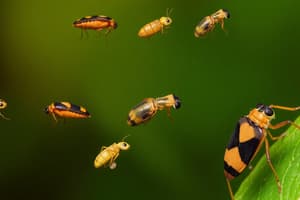Podcast
Questions and Answers
Which of the following characteristics are true for mammals?
Which of the following characteristics are true for mammals?
- They can live both on land and in water.
- They feed milk to their young. (correct)
- They lay eggs with hard shells.
- They have feathers.
Fish breathe oxygen through lungs.
Fish breathe oxygen through lungs.
False (B)
What is a common characteristic of reptiles?
What is a common characteristic of reptiles?
They lay eggs with soft shells.
Amphibians start their life in ______ and as adults live on land.
Amphibians start their life in ______ and as adults live on land.
Match the following animal types with their characteristics:
Match the following animal types with their characteristics:
Which of the following statements is true about insects?
Which of the following statements is true about insects?
All birds can fly.
All birds can fly.
What is the primary distinguishing feature of arthropods?
What is the primary distinguishing feature of arthropods?
The skeleton of insects is on the ______ of their body.
The skeleton of insects is on the ______ of their body.
Which of the following statements is true regarding amphibians?
Which of the following statements is true regarding amphibians?
Invertebrates have a backbone.
Invertebrates have a backbone.
Name one type of arthropod.
Name one type of arthropod.
Birds lay ______ eggs.
Birds lay ______ eggs.
Match the animal group with their characteristic:
Match the animal group with their characteristic:
Which of the following is NOT a characteristic of fish?
Which of the following is NOT a characteristic of fish?
All insects have 8 legs.
All insects have 8 legs.
The young of amphibians start their life with a ______ and gills.
The young of amphibians start their life with a ______ and gills.
Flashcards
Mammals
Mammals
Animals that feed milk to their young, have fur/hair, and use lungs to breathe.
Fish
Fish
Animals that live in water, have scales, breathe through gills, and lay eggs without shells.
Reptiles
Reptiles
Animals that live on land or water, lay eggs with soft shells, have dry, scaly skin and do not take care of their young.
Birds
Birds
Signup and view all the flashcards
Amphibians
Amphibians
Signup and view all the flashcards
Insects
Insects
Signup and view all the flashcards
Spiders
Spiders
Signup and view all the flashcards
Mollusks
Mollusks
Signup and view all the flashcards
Vertebrates
Vertebrates
Signup and view all the flashcards
Invertebrates
Invertebrates
Signup and view all the flashcards
What are the characteristics of mammals?
What are the characteristics of mammals?
Signup and view all the flashcards
What are the characteristics of fish?
What are the characteristics of fish?
Signup and view all the flashcards
What are the characteristics of reptiles?
What are the characteristics of reptiles?
Signup and view all the flashcards
What are the characteristics of birds?
What are the characteristics of birds?
Signup and view all the flashcards
What are the characteristics of amphibians?
What are the characteristics of amphibians?
Signup and view all the flashcards
What are the characteristics of arthropods?
What are the characteristics of arthropods?
Signup and view all the flashcards
Study Notes
Animal Life Cycles
- Mammals:
- Feed milk to their young.
- Young look like parents.
- Most mammals do not lay eggs.
- Mammals care for their young.
- Breathe air using lungs.
- Have fur or hair.
- Some examples: dolphins, whales, cats, dogs, humans.
Animal Life Cycles (cont.)
- Fish:
- Live in water.
- Have scales.
- Breathe oxygen through gills.
- Their eggs do not have shells.
Animal Life Cycles (cont.)
- Reptiles:
- Live on land or in water.
- Examples: turtles, lizards, snakes.
- Lay eggs with soft shells.
- Do not care for their young.
- Have dry, scaly skin.
Animal Life Cycles (cont.)
- Birds:
- Have feathers.
- Lay eggs with hard shells.
- Care for their young, with mothers feeding the young.
- Not all birds can fly (e.g., penguins, ostriches).
Animal Life Cycles (cont.)
- Amphibians:
- Live both on land and in water.
- Examples: frogs, toads, salamanders.
- Lay eggs with soft shells.
- Have moist skin.
- Young do not resemble adults, starting with tails and gills.
- Gills and tail disappear as legs and lungs develop.
Invertebrates
- Types of invertebrates:
- Arthropods: Spiders, insects, lobsters, crabs, centipedes
- Annelids: Worms
- Sponges
- Cnidarians: Jellyfish
- Mollusks: Snails
- Echinoderms: Starfish
Invertebrates (cont.)
- Arthropods - Insects:
- Have 3 body sections, 6 legs and 2 antennae.
- Use antennae to smell and sense.
- Have an exoskeleton (external skeleton).
- Mostly lay eggs.
- Examples: Wasps, butterflies, ladybugs, ants.
Invertebrates (cont.)
- Arthropods - Spiders:
- Have 8 legs and 2 body parts.
Invertebrates (cont.)
- Mollusks - Snails and Slugs:
- Have a slimy foot.
- Some have shells.
Life Cycle Diagrams
- Diagrams for mammals, reptiles, fish, birds, and amphibians show the stages.
- Diagrams for butterfly and other insects also show stages.
Studying That Suits You
Use AI to generate personalized quizzes and flashcards to suit your learning preferences.




